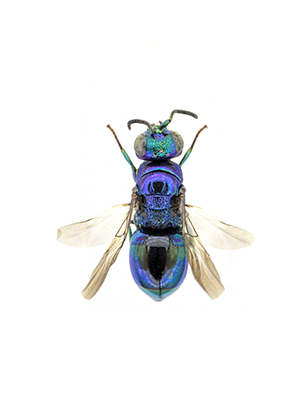Last updated on November 28th, 2023
 From: Kimsey L.S. & Bohart R.M., 1990 (1991) – The chrysidid wasps of the world. Oxford University Press, ix-652 pp.
From: Kimsey L.S. & Bohart R.M., 1990 (1991) – The chrysidid wasps of the world. Oxford University Press, ix-652 pp.
Synonymy
Omalus Panzer 1801:13. Type: Chrysis aenea Fabricius 1787:284. Monobasic.
Homalus Saunders 1873:411. Invalid emendation of Omalus Panzer 1801.
Generic diagnosis
Scapal basin usually deep and smooth, asetose; malar space less than 1 MOD and bisected horizontally by genal carina; head lenticular, with carinate postocular edge, pronotum impressed laterally; vertex, pronotum medially and scutum often impunctate; mesopleuron with scrobal sulcus horizontal, extending from lateroventral margin of pronotum to scrobe with single carina dorsally, transpleural carina reaching apex of propodeal angle; scutellum with two flattened areas along anterior margin; metanotum evenly rounded; fore wing medial cell asetose, medial vein strongly arched and arising before cu-a, stigma short, broad, and apically rounded; fore femur ventrally carinate and often subapically broadened, tarsal claws with 2-3 subsidiary teeth; T-I—III strongly convex; T-III apical margin often sinuate laterally, occasionally transparent, usually without apicomedial notch; genital capsule.
Hosts
Omalus are parasites of sphecid wasps in the subfamily Pemphredoninae.
Distribution
Omalus occur in all but the Australian Region. The vast majority of species are Holarctic.
Discussion
Historically the genus Omalus has been divided into four or as many as eight subgenera. We have examined these subgeneric groupings in detail and have found only four to be valid. These four groups have sufficiently discrete diagnostic features that we give them generic status. The resulting genera are Omalus s.s., Holophris, Pseudomalus, and Philoctetes.
Omalus s.s. is a group of 20 species, characterized by the genal carina bisecting the malar space, pronotum and vertex mostly impunctate except laterally, scutum impunctate or with scattered punctures, scrobal sulcus nearly horizontal, extending from the lateral pronotal margin to scrobe, and the anterior margin of the scutellum with two smooth, flattened areas. In addition, the apical margin of T-III is sinuous, usually without a medial notch, and usually only narrowly transparent. In addition, the metanotum is evenly rounded. T-III has a deep apical notch in biaccinctus, and congoensis has T- III with a broad transparent rim, a small lateral angle, and deep medial notch.
We have found no reliable way of determining the sex of individuals in Omalus, without exserting the genitalia.
This genus has been revised only in a few restricted geographic areas: the Afrotropical Region (Kimsey 1988a), Europe (Linsenmaier 1951, 1959a, b), and the Nearctic Region (Bohart and Campos 1960, Bohart and Kimsey 1982). However, all of these studies treated Omalus in the broad sense, with Pseudomalus, Diplorrhos, and Holophris as subgenera.
European species
- Omalus aeneus (Fabricius, 1787)
- Omalus aeneus chevrieri Tournier, 1877
- Omalus aeneus japonicus (Bischoff, 1910)
- Omalus aeneus puncticollis Mocsáry, 1887
- Omalus biaccinctus (Buysson, 1893)
- Omalus chlorosomus mallorcanus Linsenmaier, 1959
- Omalus magrettii (Buysson, 1890)
- Omalus miramae (Semenov, 1932)
- Omalus nigromaculatus Linsenmaier, 1987
- Omalus politus (Buysson, 1887)
- Omalus zarudnyi (Semenov, 1932)
Copyright, Authorship, and Ownership statements
All text and images of this page are copyright ©️ Chrysis.net unless otherwise stated - please see individual cases for authorship and copyright details. The specimens pictured are from the authors' or other collaborators' personal collections and from the collections of various museums. Unless otherwise specified, the whole content of this web site is for personal, non-commercial, scientific, and educational purposes given proper accreditation to the page from which they were derived are provided, and under Chrysis.net Terms and Conditions.
For citation purposes
Agnoli G.L. & Rosa P. (2024) Genus Omalus Panzer, 1801, in: Chrysis.net website. Interim version 18 April 2024, URL: https://www.chrysis.net/database/genus-omalus/.




